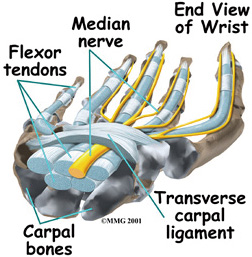|
|
| Pain& Relief |
 |
|
|
 How can the use of a computer mouse lead to Carpal Tunnel Syndrome? How can the use of a computer mouse lead to Carpal Tunnel Syndrome? |
Carpal Tunnel Syndrome is a progressive and painful condition caused by the compression of a key nerve in the wrist. It occurs when the median nerve, which runs from the forearm into the hand, becomes pressed or squeezed at the wrist. Symptoms usually start gradually, with irritation and tingling, weakness, pain, or numbness in the hand and wrist, radiating up the arm. As symptoms worsen, people might feel the tingling throughout the day, as well as decreased grip strength making it difficult to form a fist, grasp or perform other essential or simple tasks. |
|
|
| 1) Unnatural hand held position: |
|
Excessive pronation of the forearm while using conventional mice is almost unavoidable. The user's hand is held in a horizontal palm-down position with the wrist lying on a flat surface. However, if a seated person lays their hand on a desk in a natural and relaxed position, the hand would be in an upright position. Most conventional mice force the hand, wrist, and forearm to be twisted at an approximate 90 degrees away from the natural and relaxed position. This requires constant strain applied to the hand, wrist, and forearm in order to maintain the position. The unavoidable twisting is a strain on the related muscles, tendons, and nerves. |
|
 |
|
| 2) Excessive finger clicking: |
|
All conventional mice and most ergonomic mice require constant finger clicking that results in continual strain on the related muscles and tendons. This repetitive strain on the hand and fingers eventually leads to inflammation and swelling of the flexor tendons. Carpal Tunnel Syndrome occurs when swollen flexor tendons compress the median nerve, which runs from the arm to the hand through a space in the wrist called the carpal tunnel found under the transverse carpal ligament. |
|
(3) Stress from long time gripping:
Users have to keep gripping most conventional mice to move and control the cursor, long time stress from gripping leads to strain on hand. |
| |
(4) Pressure and friction between wirst and desk surface:
For all conventional mice, user's hand keeps palm down position. The downside of wrist has to bear the weight of hand and contact the desk surface all the time during usage. The pressure on the wrist will press the transverse carpal ligament and reduce the space for medium nerve. |
| |
(5) Strain from finger hovering for preparation to click:
For all conventional mice, some fingers of user's hand especially fingers excuting left clicking and right clicking have to prepare to click all the time before next clicking. So these fingers can't get relaxed all the time. |
| |
(6) Insufficient rest during long periods of mouse usage:
Most of us don’t take frequent or sufficient breaks when using a computer for an extended period of time. Especially when using a conventional mouse, the hand tends to stay in an unnatural position the entire time, even when not operating the mouse. |
|
|
|